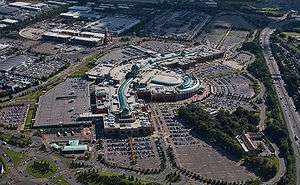Trafford Centre
|
The main Trafford Centre mall is pictured centre and the Barton Square extension is towards the top left. | |
| Location |
Dumplington, Trafford, Greater Manchester, England |
|---|---|
| Opening date | 10 September 1998[1] |
| Developer | The Peel Group |
| Owner | Intu Properties |
| Architect |
Chapman Taylor[2] Leach Rhodes Walker |
| No. of stores and services | 280 |
| No. of anchor tenants |
6
|
| Total retail floor area |
Retail: 185,000 m2[5][6] |
| No. of floors | 4 |
| Parking | 12,500[7] |
| Website |
www |
The Trafford Centre (also known as the Intu Trafford Centre)[8] is a large indoor shopping centre and leisure complex in Greater Manchester, England. In the Metropolitan Borough of Trafford, the centre is close to the Trafford Park industrial estate and approximately five miles west of Manchester city centre. The Trafford Centre opened in 1998 and is the second largest shopping centre in the United Kingdom by retail size.[9][10] It was developed by the Peel Group and is owned by Intu Properties following a £1.65 billion sale in 2011[11] - the largest single property acquisition in British history.[12] As of 2016, the centre has a market value of £1.9 billion.[13]
The site was owned by the Manchester Ship Canal Company until 1986, when the company was acquired by John Whittaker of Peel Holdings, who had plans to build an out-of-town shopping centre. The planning process was one of the longest and most expensive in the history of the United Kingdom; concerns surrounded the effect the shopping centre might have on retailers in the smaller towns and villages in the Greater Manchester conurbation and potential traffic problems caused by the its proximity to the M60 motorway.[14] Ultimately, the matter was decided by the House of Lords in 1996, which voted in favour of the development.[15][16]
Twelve years after the Trafford Centre was first conceptualised by the Peel Group, it opened on 10 September 1998. Construction took 27 months at a cost of £600 million - approximately £1 billion in 2016.[14] Two further extensions have since opened, Barton Square and the Great Hall in 2008, at a combined cost of over £100 million. Its vivid and quirky rococo/late baroque architectural style pays homage to the history of the area. The Orient food hall is themed as a steam ship, reflecting the centre's proximity to the Manchester Ship Canal.[17]
Ten per cent of the UK population lives within a 45-minute drive of the shopping centre[6] which attracts more than 35 million visits annually.[18] It has Europe's largest food court in The Orient and the UK's busiest cinema, attracting more than 28,500 visitors each week.[6] There are over 11,500 car parking spaces and construction is expected to commence in 2016 on Metrolink Phase 4 which will create a direct tram link from the Trafford Centre to Manchester city centre via Pomona.[19]
History
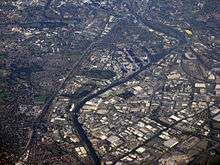

Manchester City Council[nb 1] retained seats on the board of the Ship Canal Company until the mid-1980s. By then the arrangement had become "meaningless", as the majority of the company's shares were controlled by property developer, John Whittaker. Crucially, the council were powerless and Peel held voting rights due to majority shareholding. In 1986, the council gave up all but one of its seats for a payment of £10 million and extricated itself from a possible conflict of interest, as Whittaker was proposing to develop the large out-of-town shopping centre on company land at Dumplington, which became the Trafford Centre.
Manchester City Council opposed the development, believing it would impact negatively on the city centre economy, but accepted it was "obviously in the interests of the shareholders".[21] The company paid £7 million in cash and £3 million was invested in a joint venture company, Ship Canal Developments, set up by Whittaker and the council to provide resources and development expertise for the regeneration of east Manchester.[22]
Peel Holdings submitted a planning application to Trafford Metropolitan Borough Council for a development on approximately 300 acres of land in 1986. The application was "called in" by the Secretary of State for the Environment and legal disputes ensued requiring two public inquiries before planning permission was granted. Issues involved congestion on the M60 orbital motorway,[23] and some believed the development would have adverse consequences on shopping centres throughout Greater Manchester region and beyond.[23] Planning permission was granted in 1993[24] before being rejected by the Court of Appeal.[24] It was reinstated in 1995 when the House of Lords gave approval for the development.[25]
Construction began in 1996 and the centre opened on 10 September 1998 becoming the UK's last "mega mall" which combined retail, dining and leisure facilities.[26] On opening, the Trafford Centre was the largest shopping centre in the UK but lost the title to Bluewater in Kent in 1999.[26] However, due to numerous expansions since 2006, the Trafford Centre is now larger than Bluewater.
The Peel Group sold the centre to Capital Shopping Centres (CSC) in January 2011 for £1.6 billion[27] and John Whittaker, chairman of Peel Group, became deputy chairman of CSC.[28] Peel owner John Whittaker later said the company could have sold the centre for over £2 billion if they had received cash[29] but the £1.6 billion deal remained the largest property transaction in British history,[12][30] and the biggest European property deal of 2011.[31]
The Trafford Centre is valued at £1.7 billion by its owners, Capital Shopping Centres, and has an annual income of £85.3 million, a £400 headline rent[6] and has an ABC1 visitor percentage of 71%.[7] By comparison, the Metrocentre which is the second largest shopping centre in the United Kingdom (after the Trafford Centre) is valued at £864 million, an annual property income of £50.4m and an ABC1 visitor percentage of 57% of ABC1 customers.[6]
The centre was re-branded as Intu Trafford Centre in mid-February 2013 by parent group Capital Shopping Centres, at a cost of £7 million, and all remaining centres owned by that company followed suit.[32]
Architecture
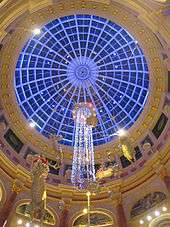
The Trafford Centre's unorthodox style of architecture was prompted by the wish to offer a unique shopping experience. John Whittaker, chairman of Peel Holdings, had to convince architects that a lavish design would not alienate shoppers.
When we first started the architects said, "you shouldn’t be doing all this and giving it all the razzmatazz and showbiz, leave that to the retailers. Make it plain, make it clinical, make it white and hospitalised and let them do the work". So then we put in the paintings, we put in the real gold leaf, we put artifacts everywhere, paintings. It is the people’s palace. It is something to attract shoppers ... to give them the Dallas effect.— John Whittaker.[33]
The design was a collaboration between the architectural practices of Chapman Taylor and Manchester-based Leach Rhodes Walker. The construction contractor was Bovis Lend Lease,[34] with structural engineering services provided by the WSP Group. Such was the size and detailing of the building, architects ended up producing over 3,000 separate shop drawings on the drawing register and the construction process required twenty-four chartered architects to work on the project full-time to monitor the construction and interior design process.[35]
The centre has four main areas across two floors, Peel Avenue, Regent Crescent, the Dome, and the Orient, and was designed so that visitors enter on both main shopping floors in equal numbers.[36] This avoids the problem where visitors do not visit the upper floors and retailers avoid upper floor units. The ODEON Cinema is on the third floor along with other leisure facilities such as Laser Quest. The Trafford Centre was built to be "future-proof" in the words of developer John Whittaker with the infrastructure for an additional fourth floor built during construction.[33]
The Trafford Centre is Rococo/late Baroque in design, with eclectic elements of Art Deco and Egyptian Revival. It is decorated primarily in shades of white, pink and gold with ivory, jade and caramel coloured marble throughout. There are three domed atria along the length of the mall, and Peel claim the middle dome is bigger than that at St Paul's Cathedral.[37] The central dome cost £5 million to construct.[33] The Trafford Centre has 45,000 square metres of marble and granite flooring from Montignosa and Quarlata in Italy at a cost of £5.8 million (1996 value)[38] and gold leaf adorns the building's columns.[37] The marble floors and handrails are polished nightly to maintain the centre's opulent appearance.[39]
The Trafford Centre has features which pay homage to the local area and North West England.[40] The Orient food hall is themed around a steam ship, paying homage to the Industrial Revolution and the nearby Manchester Ship Canal. The Lancashire Rose also permeates the décor on window panes and interior cornices. Mythical griffin statues adorn the exterior, the heraldic symbol of the de Trafford baronets who historically owned much of the land in modern-day Trafford.[41]
Others however have criticised the deception of the fake palm trees and neo-classical decorative pillars which are not made of marble but decorated medium-density fibreboard.[39] Architecture critic John Parkinson-Bailey described the Trafford Centre as a building which "will not appeal to purists" and the range of interior architecture as "bewildering".[41] The Peel Group say that the striking and extrovert architecture is aimed at providing visual delight, to make the visitor's shopping experience more vivid.[42]
Since it opened in 1998, advances have been made in lighting design and efficiency such as the growth of LED lighting. Since 2009, incandescent light bulbs have been phased out in favour of LED lighting allowing different shades of hue as well as greater efficiency.[43][44]
Portraits around the walls of the mall depict members of the Whittaker family, founders of owner Peel Holdings. A Mercedes car belonging to the mother of Peel Holdings' chairman, John Whittaker, is displayed on the first floor mall outside F. Hinds.[45]
Focal points

The Orient
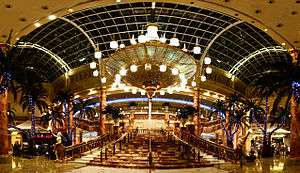
The Orient is in a central hall-like spur and is a 1,600-seat food court themed on a 1930s liner.[17] The Orient incorporates designs from around the world including China, New Orleans, Egypt, Italy, America and Morocco.[46] On two floors, it has restaurants and bars including the Exchange Bar & Grill, TGI Fridays, Coast to Coast (Restaurant), Starbucks, Est Est Est, Ma Potter's, Nando's and Cathay Dim Sum. There are several fast food outlets – McDonald's, KFC, Subway, Harry Ramsden's and Pizza Hut among others. Burger King moved into the Trafford Centre in November 2011.[47] There is also a giant screen which is used for advertising and events.
Great Hall
The Great Hall, opened in March 2007, although a Costa Coffee outlet opened earlier in January 2007. This glazed structure houses five restaurants and cafes. Construction took 18 months at a cost of £26 million.[48] It houses a sweeping staircase featuring hundreds of metres of marble balustrade from China and what the centre claims to be the largest chandelier in the world.[48] It was designed by English lighting consultants and manufactured in China; assembly and installation was done by local contractors. The chandelier has three levels of plant walkways inside, is around 11 m (36 feet) wide and 15 m (49 feet) high, weighs around five tonnes.
Facilities
Shopping
Peel Avenue

Peel Avenue is home to high street shops such as an Apple Store, H&M, and Boots and department stores, John Lewis which opened in 2005 the four-storey Marks and Spencer, Selfridges and Debenhams. The retail unit now occupied by John Lewis was previously a market-themed area for independent stores named the Festival Village.
Marks and Spencer has an outside entrance to the foodhall. The dome in the middle of the centre is home to more upmarket stores such as the first Selfridges outside London.[49]
Regent Crescent
Regent Crescent is home to many high-end designer stores, such as Karen Millen, Jane Norman, Gap and Mexx. It also houses Waterstones bookshop, and Debenhams. Other lifestyle and fashion retailers include Reiss, Mango, Monsoon, Coast, French Connection and All Saints. The crescent leads down to the main dome. Stores
Barton Square
Planning permission was granted for further expansion in October 2005. Construction started in November 2006[50] Barton Square covering 19,000 square metres (200,000 sq ft) cost £70 million, opened on 20 March 2008.[51] Its name relates to Barton-upon-Irwell and Peel's City Airport Manchester, which was originally Barton Aerodrome. It is linked to the centre by a glazed bridge. Its architecture is based on an Italian square and includes a large fountain and a campanile tower.

This section of the centre targets high-quality homewares market with units offering furniture, kitchens, bathrooms and home furnishings. Retailers operating are Next Home, BHS Home, Dwell, Laura Ashley and M&S Home. A further 630 free parking spaces have been provided. Barton Square has struggled to be economically viable since its opening in 2008. In 2009, it made an accumulated loss of £512,000 and this worsened in 2010 to £1.3 million.[52] To entice shoppers from the main mall, new facilities such as a Legoland were built. Future plans include converting it to an indoor area and increasing retail space.
Leisure
Leisure facilities include a 20-screen Odeon multiplex cinema,[53] a Laser Quest arena, Paradise Island miniature golf, a Namco Funscape with dodgems, bowling and arcade games. The adjacent Trafford Quays Leisure Village has a Chill Factore, Trafford golf centre, a skydiving centre, and an indoor football facility.[54] A Sea Life Centre aquarium opened in Barton Square in June 2013.[55][56]
Future expansion
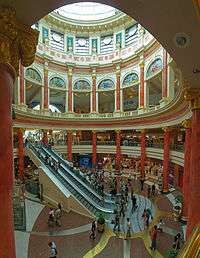
Developer John Whittaker, stated in 2011 that it is "future proof" with areas available on the third floor for possible new developments.[33] After CSC's takeover in November 2010, chief executive, David Fischel, signalled a desire to expand the centre.[57] Immediate plans include constructing a roof over Barton Square and expanding the John Lewis and Marks & Spencer outlets, large anchor stores.[58]
Long-term plans include expanding Barton Square retail space, building retail areas on unused land and attracting retailers that currently do not have a presence such as House of Fraser, Robert Dyas and Primark.[59] Plans include utilising vacant space on upper floors to create new retail opportunities.[59] CSC applied for planning application to increase retail space on the 2nd floor in Barton Square from 18,580m2 to 28,966m2 in September 2011 which would increase the Trafford Centre's retail size to approximately 195,000m2 from 185,000m2.[60]
Accommodation
Intu Trafford Centre has 4 hotels on site
- Premier Inn Trafford Centre North
- Premier Inn Trafford Centre South
- Premier Inn Trafford Centre West
- Travelodge Trafford Park
Travel and transport

Road
The Trafford Centre has 12,500 car spaces and 350 coach spaces and is off the M60 (Junctions 9 and 10). Its popularity has resulted in traffic congestion on the M60's Barton High-Level Bridge, requiring a link road adjacent to the M60 crossing the ship canal on a new swing bridge.
All vehicles entering the centre have number plate details recorded via automatic number plate recognition. Since its introduction in 2003 at a cost of £220,000[1] the system has reduced the number of thefts of and from vehicles to a level described as "negligible".[61] The ANPR tracks cars which have been used for serious offences and details of any car with such a number plate can then be passed to Stretford Police Station.[1]
Bus
There is a bus station at the west end of the Trafford Centre with services to most towns in Greater Manchester.[62]
The most frequent routes are:
- X50: Manchester Piccadilly Gardens - Manchester United - Salford Quays - Trafford Centre
- 250: Manchester Piccadilly Gardens - Manchester University - Hulme - Manchester United - Trafford Park - Trafford Centre
Coach park
There is a coach park adjacent to the John Lewis store.
Future transport
The nearest Manchester Metrolink station is Stretford. There are plans for a Metrolink line to the Trafford Centre including a dedicated station, but resources are currently being focused on completing the current extension of the Metrolink by 2016. Metrolink and the local authorities have declared that the link must be at least in part privately funded by developers.[63]
Planning permission was granted for the construction of a 600-metre (2,000 ft) canal linking the Trafford Centre with the Manchester Ship Canal in 2006, allowing the introduction of a water taxi service to and from Salford Quays. Construction could take a year, although the project has not yet started.[64]
In popular culture
The Trafford Centre sponsors Salford Red Devils rugby league club. Shortly after its opening, it was the setting for Shopping City, a BBC2 daytime programme. The Trafford Centre and Trafford Park were featured in the 2008 BBC documentary series, Britain From Above, which highlighted the transition from industry to services.[65] In 2008 the Orient food court was used as a location in the post-apocalyptic drama Survivors.[66] In 2010, the shopping centre was the focal point of the BBC's The Apprentice in which during week 5 both teams had to sell designer clothes in the centre for one day.[67]
See also
- List of shopping centres in the United Kingdom
- Manchester Arndale – 'In town' shopping centre in Manchester city centre
- Economy of Manchester
References
- Footnotes
- ↑ Manchester Corporation was subsumed into the newly created Greater Manchester County Council in 1974 until 1986, when the unitary authority of Manchester City Council was established.[20]
- Citations
- 1 2 3 "Trafford Centre information pack" (PDF). Trafford Centre. Retrieved 10 July 2011.
- ↑ "The Intu Trafford Centre - Chapman Taylor" (PDF). Chapman Taylor. Retrieved 25 March 2012.
- ↑ Yarwood, Sam (4 December 2015). "Trafford Centre BHS store to close in the New Year". Manchester Evening News. Retrieved 5 December 2015.
- ↑ "Trafford extends Barton Square homewares offer". www.shopping-centre.co.uk. 19 May 2008.
- 1 2 3 4 "Shopping Centres – Trafford Centre". Capital Shopping Centres. Retrieved 15 September 2011.
- 1 2 3 4 5 6 "Portfolio". Capital Shopping Centres. Retrieved 17 June 2011.
- 1 2 "The Trafford Centre, Manchester" (PDF). Capital Shopping Centres. Retrieved 28 March 2012.
- ↑ Glendinning, Amy. "The Intu Trafford Centre - the new name for Manchester's shopping mecca". men. Retrieved 13 April 2016.
- ↑ "Intu - Trafford Centre Key Facts". Intu Properties. Retrieved 29 November 2014.
- ↑ "Portfolio – Our Centres". Capital Shopping Centres. Retrieved 17 June 2011.
- ↑ "Portfolio". Capital Shopping Centres. Retrieved 17 June 2011.
- 1 2 Ruddick, Graham (27 January 2011). "Capital Shopping Centres seals £1.6bn Trafford Centre deal despite Simon Property Group's concerns". The Telegraph. Retrieved 15 September 2011.
Capital Shopping Centres has sealed the UK's largest ever property transaction after 80pc of shareholders backed its £1.6bn acquisition of the Trafford Centre.
- ↑ "Intu Properties - Final Results". Intu Properties. Retrieved 20 December 2014.
- 1 2 "The Shops – Trafford Centre". www.manchester2002-uk.com. Retrieved 3 November 2010.
- ↑ House of Lords (1995) "Opinions of the Lords of Appeal for Judgment in the cause Bolton Metropolitan District Council and others (respondents) versus Secretary of State for the Environment and others (appellants)" 24 May, written by Lord Lloyd of Berwick.
- ↑ Trafford Centre (1997) "From de Trafford to the House of Lords" Trafford Centre Insight, Brochure.
- 1 2 "1999 European Shopping Centre Awards". International Council of Shopping Centres. Retrieved 25 March 2012.
For acknowledging an area's past while providing retail and services for today. Trafford Centre's architecture is inspired by classicism, while the food court is anchored by a traveling steamship that acknowledges the Industrial Revolution development of the city.
- ↑ Bounds, Andrew (29 December 2010). "Tills ring at Trafford Centre". Financial Times.
Visitor numbers increased by 6.4 per cent year-on-year to more than 35m.
- ↑ "Metrolink Trafford Park Line - Next steps & Progress". TFGM. Retrieved 3 January 2016.
- ↑ Greater Manchester County Record Office (with Manchester Archives) Guide to Local Government Records (DOC), Manchester Library & Information Service, retrieved 7 August 2011
- ↑ King 2006, pp. 98–100
- ↑ King, Ray (2006). Detonation: Rebirth of a City. Clear Publications. pp. 98–100. ISBN 0-9552621-0-0.
- 1 2 "Taking a malling". economist.com. 10 September 1998. Retrieved 13 September 2011.
- 1 2 Stevenson, Tom (15 July 1994). "Slow net asset growth hits Peel". The Independent.
- ↑ http://www.poptel.org.uk/trafford.park/7.HTM
- 1 2 Hall, James (18 September 2010). "Westfield Stratford – Britain's last mega-mall". The Telegraph. Retrieved 16 September 2011.
- ↑ "Trafford Centre in Greater Manchester sold by Peel". BBC. 25 November 2010.
- ↑ "About us – Non-Executive Directors". Capital Shopping Centres. Retrieved 12 July 2011.
- ↑ Hodgson, Neil (13 December 2010). "Capital Shopping Centres rejects call to abandon Trafford Centre deal with Peel". Liverpool Daily Post. Retrieved 27 March 2012.
- ↑ Thomas, Daniel (26 January 2011). "Investors agree CSC deal for Trafford Centre". The Financial Times. Retrieved 27 March 2012.
The deal is the largest-ever UK property transaction. Mr Whittaker, Peel chairman, told the shareholder meeting the sale had nothing to do with the amount of money, which would have been higher through a cash sale, but was related to the long-term future of his family business.
- ↑ Packard, Simon (23 February 2012). "Capital Shopping Earnings Rise as Trafford Centre Purchase Lifts Revenue". Bloomberg. Retrieved 27 March 2012.
The company’s 1.6 billion-pound purchase of the Trafford Centre in Manchester, England, in January 2011 was the biggest single property transaction in Europe last year, according to New York-based Real Capital Analytics Inc.
- ↑ Glendinning, Amy (16 January 2013). "The Intu Trafford Centre - the new name for Manchester's shopping mecca". Manchester: Manchester Evening News. Retrieved 3 February 2013.
- 1 2 3 4 "Whittaker has more to offer than the rococo". Financial Times. 11 February 2011. Retrieved 15 September 2011.
- ↑ "Bovis' reputation is cornering the shopping market", Contract Journal, 17 September 1997
- ↑ Parkinson Bailey. p. 274. Missing or empty
|title=(help) - ↑ "intu Trafford Centre" (PDF). traffordcentre.co.uk. Retrieved 14 June 2015.
- 1 2 Swanton, Oliver (2 September 1998). "The mall that ate Manchester". The Independent.
- ↑ "Trafford Centre fact file". Lancashire Telegraph. 19 December 1997. Retrieved 10 July 2011.
- 1 2 "Trafford Centre – shopping hell or heaven?". bbc.co.uk. 31 December 2001. Retrieved 3 November 2010.
- ↑ "History and vision - The Peel Group". The Peel Group. Retrieved 25 March 2012.
- 1 2 Parkinson-Bailey. p. 273. Missing or empty
|title=(help) - ↑ "Design Statement – The Interior". www.traffordcentre.co.uk. Retrieved 3 November 2010.
- ↑ "The Dome in technicolour". Trafford Centre. 9 March 2009. Retrieved 16 February 2012.
- ↑ "Light fantastic at The Trafford Centre". Trafford Centre. 28 November 2011. Retrieved 16 February 2012.
- ↑ Barry, Chris (3 February 2005). "The man who built Peel Holdings". Manchester Evening News. Retrieved 20 April 2012.
- ↑ "The development and its size". www.traffordcentre.co.uk. Retrieved 3 November 2010.
- ↑ "Whopper deals For Burger King as it expands on shopping centre presence". eatoutmagazine.co.uk. 4 October 2011. Retrieved 5 October 2011.
- 1 2 "Biggest chandelier in the world?". Manchester Evening News. 15 March 2007. Retrieved 10 July 2011.
- ↑ "The development and its size – Regent Crescent". www.traffordcentre.co.uk. Retrieved 3 November 2010.
- ↑ "Trafford development". Manchester Evening News. 14 November 2006.
- ↑ Kirby, Dean (26 March 2008). "New Trafford Centre wing". Manchester Evening News. Retrieved 25 March 2012.
- ↑ Binns, Simon (11 October 2011). "Barton Square Sees Losses Widen". Manchester Confidential. Retrieved 25 March 2012.
- ↑ "Auditorium information for Trafford Centre". ODEON. Retrieved 27 April 2012.
- ↑ "Trafford Quays Leisure Village". Trafford Centre. Retrieved 27 April 2012.
- ↑ "Capital Shopping Centres to open aquarium at Trafford Centre's Barton Square". Manchester Evening News. 25 April 2012. Retrieved 27 April 2012.
- ↑ "Manchester Confidential your guide to city life, eating out, night life, food and drink, bars, and more". Manchester Confidential. Retrieved 14 June 2015.
- ↑ Jupp, Adam (24 February 2011). "Trafford Centre to get £50m makeover". Manchester Evening News. Retrieved 10 July 2011.
- ↑ "Trafford Centre stays buoyant – but difficult year ahead". Manchester Evening News. 17 May 2011.
- 1 2 Jupp, Adam (26 November 2010). "Going up: Trafford Centre plans extra floors to bring in Primark and House of Fraser". Manchester Evening News.
- ↑ "Planning application for Barton Square". salford.gov.uk. 28 September 2011. Retrieved 15 October 2011.
- ↑ Scheerhout, John (23 May 2004), "Spy in sky cure for car crime", Manchester Evening News, retrieved 12 October 2009
- ↑ "Network Map Salford". tfgm.com. Retrieved 14 June 2015.
- ↑ "Transport chiefs 'lining up trams to Trafford Centre". menmedia.co.uk. 29 August 2010. Retrieved 3 November 2010.
- ↑ "Waterway to get the shops!". Manchester Evening News. 20 January 2006. Retrieved on 29 January 2008.
- ↑ "Story: Shopping Nation". BBC. Retrieved 9 September 2011.
- ↑ "Recent Projects at Peel Film and TV locations - Film & TV Locations - MediaCityUK". filmandtvlocations.co.uk. Retrieved 14 June 2015.
- ↑ "Video: Apprentice teams set up shops in Trafford Centre". Manchester Evening News. 4 November 2010. Retrieved 6 November 2010.
- Bibliography
- Parkinson-Bailey, John J (2000). Manchester: an Architectural History. Manchester: Manchester University Press. ISBN 0-7190-5606-3.
External links
| Wikimedia Commons has media related to Trafford Centre. |
- Official website
- The Trafford Centre, Manchester - brochure from CSC Retail
Coordinates: 53°28′06″N 2°20′56″W / 53.4684°N 2.3489°W
